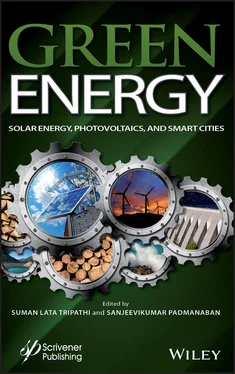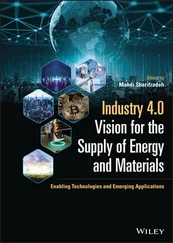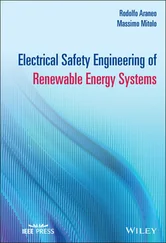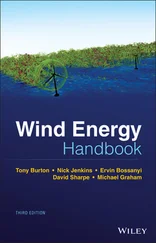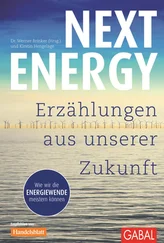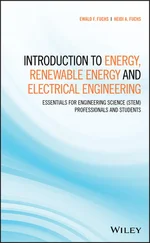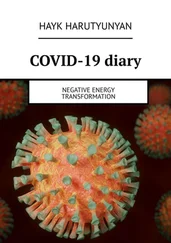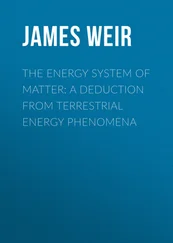1 Cover
2 Title Page
3 Copyright
4 Preface
5 1 Fabrication and Manufacturing Process of Solar Cell: Part I 1.1 Introduction 1.2 Fabrication Technology of Diode 1.3 Energy Production by Equivalent Cell Circuitry 1.4 Conclusion References
6 2 Fabrication and Manufacturing Process of Solar Cell: Part II 2.1 Introduction 2.2 Silicon Solar Cell Technologies 2.3 Homojunction Silicon Solar Cells 2.4 Solar Si-Heterojunction Cell 2.5 Si Thin-Film PV Cells 2.6 Perovskite Solar Cells 2.7 Future Possibility and Difficulties 2.8 Conclusions References
7 3 Fabrication and Manufacturing Process of Perovskite Solar Cell 3.1 Introduction 3.2 Architectures of Perovskite Solar Cells 3.3 Working Principle of Perovskite Solar Cell 3.4 Components of Perovskite Solar Cell 3.5 Fabrication of Perovskite Films 3.6 Manufacturing Techniques of Perovskite Solar Cells 3.7 Encapsulation 3.8 Conclusions References
8 4 Parameter Estimation of Solar Cells: A State-of-the-Art Review with Metaheuristic Approaches and Future Recommendations 4.1 Introduction 4.2 Related Works 4.3 Problem Formulation 4.4 Salient Simulations and Discussions for Future Work 4.5 Conclusions References
9 5 Power Electronics and Solar Panel: Solar Panel Design and Implementation 5.1 Chapter Overview 5.2 Challenges in Solar Power 5.3 Solar PV Cell Design and Implementation 5.4 MPPT Scheme for PV Panels 5.5 Way for Utilization of PV Schemes 5.6 Future Trends 5.7 Conclusion References
10 6 An Effective Li-Ion Battery State of Health Estimation Based on Event-Driven Processing 6.1 Introduction 6.2 Background and Literature Review 6.3 The Proposed Approach 6.4 Experimental Results and Discussion 6.5 Conclusion Acknowledgement References
11 7 Effective Power Quality Disturbances Identification Based on Event-Driven Processing and Machine Learning 7.1 Introduction 7.2 Background and Literature Review 7.3 Proposed Solution 7.4 Results 7.5 Discussion 7.6 Conclusion Acknowledgement References
12 8 Sr2SnO4 Ruddlesden Popper Oxide: Future Material for Renewable Energy Applications 8.1 Introduction 8.2 Experimental Work 8.3 Experimental Results 8.4 Conclusions Acknowledgement References
13 9 A Universal Approach to Solar Photovoltaic Panel Modeling 9.1 Introduction 9.2 PV Panel Modeling: A Brief Overview 9.3 Proposed Model 9.4 Current Model 9.5 Voltage Model 9.6 Simulation Results 9.7 Conclusion Acknowledgement References
14 10 Stepped DC Link Converters for Solar Power Applications 10.1 Introduction 10.2 Power Converters for Solar Power Applications References
15 11 A Harris Hawks Optimization (HHO)–Based Parameter Assessment for Modified Two-Diode Model of Solar Cells 11.1 Introduction 11.2 Problem Formulation 11.3 Proposed Methodology of Work 11.4 Simulation Results 11.5 Conclusions References
16 12 A Large-Gain Continuous Input-Current DC-DC Converter Applicable for Solar Energy Systems 12.1 Introduction 12.2 Proposed Configuration 12.3 Steady-State Analysis 12.4 Component Design 12.5 Real Gain Relation 12.6 Comparative Analysis 12.7 Simulation Outcomes 12.8 Conclusions References
17 13 Stability Issues in Microgrids: A Review 13.1 Introduction 13.2 Stability Issues 13.3 Analysis Techniques 13.4 Microgrid Control System 13.5 Conclusion References
18 14 Theoretical Analysis of Torque Ripple Reduction in the SPMSM Drives Using PWM Control-Based Variable Switching Frequency 14.1 Introduction 14.2 Prediction of Current and Torque Ripples 14.3 Variable Switching Frequency PWM (VSFPWM) Method for Torque Ripple Control 14.4 Conclusion References Appendix: Simulation Model CircuitsMain Model Speed & Current Loop Controllers VSFPWM for Torque Ripple Control
19 15 Energy-Efficient System for Smart Cities 15.1 Introduction 15.2 Factors Promoting Energy-Efficient System References
20 16 Assessment of Economic and Environmental Impacts of Energy Conservation Strategies in a University Campus 16.1 Introduction 16.2 Materials and Methods 16.3 Electricity Consumption Pattern in Covenant University 16.4 Conclusion References
21 17 A Solar Energy–Based Multi-Level Inverter Structure with Enhanced Output-Voltage Quality and Increased Levels per Components 17.1 Introduction 17.2 Proposed Basic Topology 17.3 Proposed Extended Structure 17.4 Efficiency and Losses Analysis in Suggested Structure 17.5 Comparison Results 17.6 Nearest Level Technique 17.7 Simulation Results 17.8 Conclusions References
22 18 Operations of Doubly Fed Induction Generators Applied in Green Energy Systems 18.1 Introduction 18.2 Doubly Fed Induction Generators (DFIG) Systems Operated by Wind Turbines 18.3 Control Scheme of Direct Current Controller 18.4 Simulation Studies of Direct Current Control of DFIG System 18.5 Characteristics of DFIG at Transient and After Transient Situation 18.6 Pulsation of DFIG Parameters with DCC Control Technique 18.7 Effects of 5th and 7th Harmonics of IS and VGRID 18.8 Load Contribution of DFIG in Grid with DCC Control Technique 18.9 Speed Control Scheme of Generators 18.10 DFIG Control Scheme 18.11 General Description About PI Controller Design 18.12 GSC Controller 18.13 Characteristics of DFIG with Wind Speed Variations 18.14 Conclusion References
23 19 A Developed Large Boosting Factor DC-DC Converter Feasible for Photovoltaic Applications 19.1 Introduction 19.2 Suggested Topology 19.3 Steady State Analyses 19.4 Design Consideration 19.5 Comparison 19.6 Simulation 19.7 Conclusion References
24 20 Photovoltaic-Based Switched-Capacitor Multi-Level Inverters with Self-Voltage Balancing and Step-Up Capabilities 20.1 Introduction 20.2 Suggested First (13-Level) Basic Configuration 20.3 Suggested Second Basic Configuration 20.4 Modulation Method 20.5 Design Consideration of Capacitors 20.6 Efficiency and Losses Analysis 20.7 Simulation Results 20.8 Comparative Analysis 20.9 Conclusions References
25 Index
26 Also of Interest
27 End User License Agreement
1 Chapter 3 Table 3.1 Photovoltaic parameters achieved for the constructed PSCs using differ...
2 Chapter 4Table 4.1 Summary of metaheuristic algorithms applied to parameter estimation of...Table 4.2 Datasheet of several PV modules as per [42].Table 4.3 Range of parameters to be estimated.Table 4.4 Comparative study of model parameters and error function of SDM using ...Table 4.5 Comparison of model parameters and error function of DDM using differe...Table 4.6 Comparison of model parameters and error function of TDM using differe...
3 Chapter 5Table 5.1 International standards for PV systems.Table 5.2 Power converter interconnected PV system [2].Table 5.3 Solar power present research challenges; opportunities and emerging tr...Table 5.4 A basic comparison of PV cell materials.Table 5.5 Parameters of the single PV panel Synenergy SEPL 100.Table 5.6 A PV generation system based classification and range [2].Table 5.7 Comparison of the MPPT algorithms.
4 Chapter 6Table 6.1 Compression Gain Over the Conventional Method.Table 6.2 Processing Gain Over the Conventional Method.
5 Chapter 7Table 7.1 Summary of the Compression Gains.Table 7.2 Classification accuracies for the four–class PQ Signals recognition (k...Table 7.3 Classification accuracies for the four–class PQ Signals recognition (N...
6 Chapter 8Table 8.1 Tolerance factor of different crystal structure.Table 8.2 Lattice parameters, density, and refinement parameters determined from...Table 8.3 Lattice parameters, density, and refinement parameters determined from...
7 Chapter 11Table 11.1 Details of some popular PV modules under standard test conditions [24...Table 11.2 Parameter ranges.Table 11.3 Comparison of parameters and fitness function for MDDM of Kyocera KC2...Table 11.4 Comparative assessment of parameters and fitness function for MDDM of...Table 11.5 Comparative evaluation of parameters and error function for MDDM of C...Table 11.6 Statistical measures of the error function.Table 11.7 p-values of Kruskal-Wallis test for different PV-models.Table 11.8 Wilcoxon rank-sum test results for different PV models.Table 11.9 Corrected p-values for Wilcoxon test adding Holm-Bonferroni correctio...
Читать дальше
